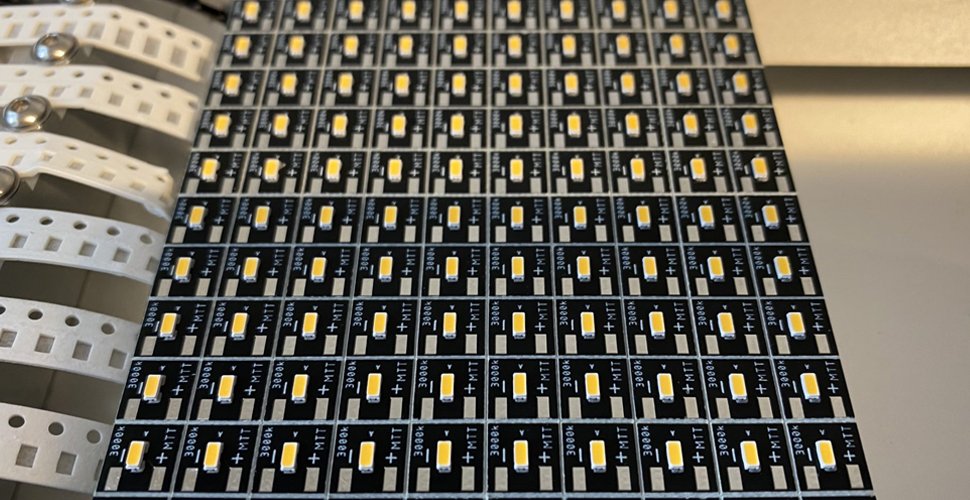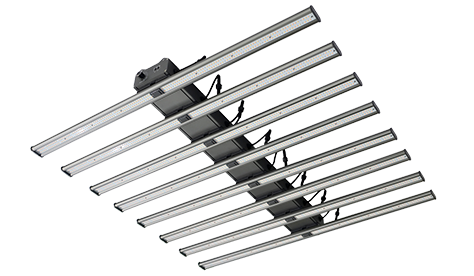Ljósdíóða er ljósgjafi sem er þekkt fyrir orkusparnað, endingu og öryggi. Á undanförnum árum hefur hröð þróun gert það að mikilvægum hluta af lífi okkar.
Vissir þú að það eru til nokkrar gerðir af LED flísum?
Í dag mun Auxgrow veita þér skilning á mismunandi gerðum LED flögum og aðgreiningu þeirra, aðstoða þig við að kanna möguleika þína, íhuga kröfur þínar og taka upplýstar ákvarðanir.
Mismunandi gerðir af LED flísum
LED, stutt fyrir ljósdíóða, er gerð hálfleiðarabúnaðar sem gefur frá sér ljós þegar rafstraumur fer í gegnum það.
Það býður upp á nokkra kosti fram yfir hefðbundnar glóperur og sparperur, sem hafa gert það sífellt vinsælli og meira notaður.
LED hafa þróast í ýmsar gerðir til að koma til móts við mismunandi kröfur. Algengar tegundir LED eru DIP LED, SMD LED og COB LED.
Hins vegar er mikilvægt að hafa í huga að fjölbreytni LED gerða nær langt út fyrir þessi þrjú dæmi.
DIP LED merking
Byrjum á fyrstu gerð LED sem kallast Direct Inline Package Light-Emitting Diode, eða DIP LED í stuttu máli.
Flestir kannast við og sjá líklega fyrir sér þessar gerðir af LED flísum þegar þeir hugsa um LED.

DIP LED klemmur hafa verið til í meira en 50 ár frá því þeir voru uppgötvaðir árið 1962. Hins vegar hefur þeim ekki verið hætt í áföngum og er áfram í notkun í dag.
DIP LED einkennist af lágspennu, lítilli hitamyndun og háum öryggisstöðlum.
Hvað er SMD LED Chip?
Önnur tegundin er yfirborðsfestuð ljósdíóða, almennt þekkt sem SMD LED.
Clip LED SMD einkennist af smæð og litlum tilkostnaði. Í samanburði við DIP LED hefur það minni formstuðul og tiltölulega meiri birtuskilvirkni.

Hvað er COB LED Chip?
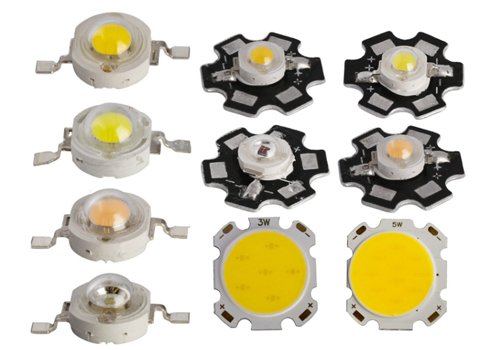
COB LED stendur fyrir Chip-on-Board Light-Emitting Diode, sem notar pökkunartækni þar sem LED flögurnar eru settar beint á hringrás með mikilli hitaleiðni.
Eins og nafnið gefur til kynna samanstendur LED COB klemma af mörgum LED flísum sem eru samþættir í einum pakka. Helstu eiginleikar þess eru meðal annars hár stöðugleiki, skilvirk hitaleiðni og samræmd ljósdreifing.
Hvernig þekkirðu LED flís?
Nú þegar þú ert kunnugur hinum ýmsu tegundum LED flísar er kominn tími til að leggja af stað í spennandi ferð til skilnings.
Finnst þér erfitt að bera kennsl á LED flísar? Ekki hafa áhyggjur! Við erum hér til að veita þér hagnýta þekkingu og þægilega tækni til að hjálpa þér að greina á milli LED flístegunda.
Við skulum kafa ofan í og lýsa leið þína til að ná tökum á LED flísagreiningu.
Lögun Chip LED
Það er auðvelt að greina þessar þrjár tegundir af LED flísum í sundur bara með því að skoða líkamlegt útlit þeirra.
DIP LED koma í ýmsum stærðum eins og kringlótt, ferningur eða óreglulegur. Þvermálsstærðir eru venjulega á bilinu 3 mm, 5 mm og 10 mm.
LED flís um borð getur verið hringlaga, ferningur eða ræmur og hægt er að aðlaga stærð þeirra út frá sérstökum umsóknarkröfum. Stærð hans hefur tilhneigingu til að aukast með hærri aflgjöfum.
SMD LED hafa fyrst og fremst ferningalaga yfirborðsfestingarpakka, með mismunandi stærðum eins og 2835 LED flísum, 3825 LED flísum, 5050 LED flísum, 5730 LED flísum, og svo framvegis.
Og hver er munurinn á þeim?
Í raun getum við skipt þessum líkananúmerum í tvo hluta. Einn hlutinn samsvarar lengdinni, en hinn hlutinn táknar breidd LED-kubbsins.

Á markaðnum er önnur tegund af SMD flís sem kallast hár afl LED flís. Þessar LED eru aðeins stærri að stærð miðað við venjulegar SMD LED. Sum þeirra eru með hálfhringlaga linsu að ofan og þess vegna eru þær einnig kallaðar LED ljósperlur eða LED einingar.
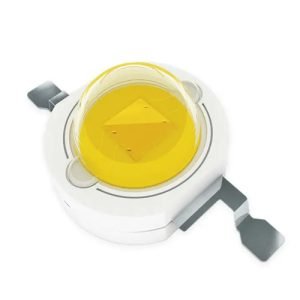
Samanburður á suðu

Fyrir LED eins og DIP flís þarftu að fara með pinnana í gegnum hringrásina og lóða þá frá botninum. Einnig er hægt að stinga þeim beint í breadboard til notkunar.
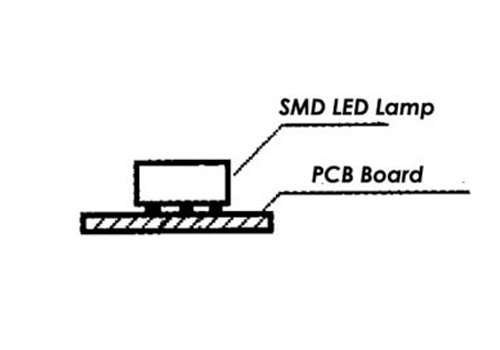
Á hinn bóginn er hægt að lóða SMD LED flís beint á hringrásarborðið án þess að þurfa að bora gat eins og DIP LED.
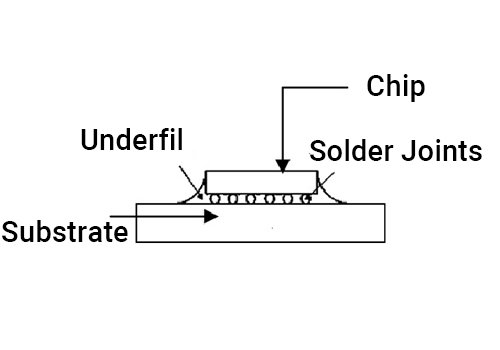
COB LED flísar eru nú þegar festar á eigin hringrásarborð, þannig að þú þarft aðeins að lóða rafmagnsvírana fyrir þá og þá er hægt að nota þá beint.
Pólun Chip LED
Pólun COB
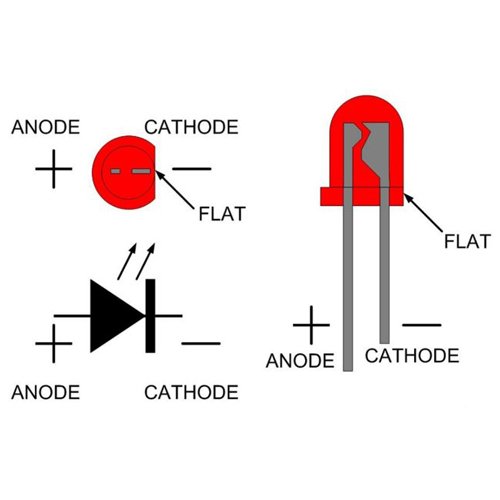
Lengri pinnar eru jákvæðir og styttri pinnar eru neikvæðir. Þegar litið er á ljósdíóðann að ofan sést einnig að önnur hliðin er flöt og pinninn undir henni er neikvæður.
Pólun DIP
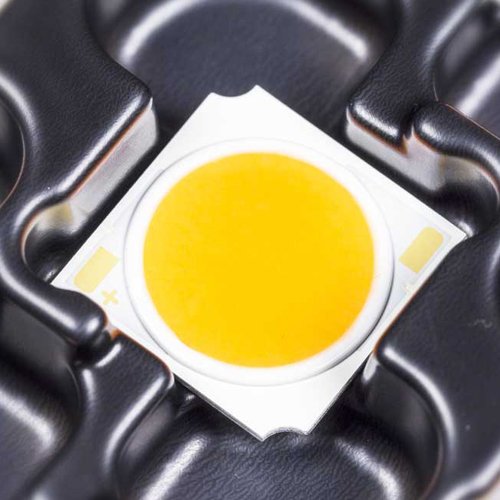
Þegar um er að ræða COB LED er pólun venjulega sýnd beint á hringrásarborðinu, sem gerir það auðvelt að greina það.
Pólun SMD

Til að ákvarða pólun SMD LED getum við fylgst með merkingum hennar hér. Pinninn með þessari merkingu er neikvæða (bakskauts) skautið.
Það eru líka mismunandi leiðir til að bera kennsl á pólun LED. Ef þú ert með margmæli er auðvelt fyrir þig að bera kennsl á hann.
Stilltu margmælinn á samfellu eða díóða stillingu og snertu rannsakana við skauta ljósdíóða. Þegar ljósdíóðan kviknar er tengin sem jákvæði rannsakandinn er tengdur við jákvæða (skautskautið).
Nauðsynlegt er að skilja sérstakar aðgerðir margmælis. Hins vegar eru sumir margmælar hið gagnstæða, eins og bendimargir. Byggt á innri hönnuninni verður pólun bakskautsnemans jákvæð þegar hún er í pípgírnum.
Notkun Chip LED
DIP LED flögur
Þar sem DIP LED hefur takmarkaða lýsingarkosti eru þau almennt notuð sem gaumljós, á skjái eða fyrir ljósaverkfæri sem eru lítil afl.

COB LED flögur
COB LED eru fyrst og fremst notuð í ljósabúnaði eins og farsímum, myndavélum eða kastljósum. Að auki eru þau valin fyrir forrit sem krefjast mikillar birtu, svo sem götuljós eða iðnaðarljósabúnað.
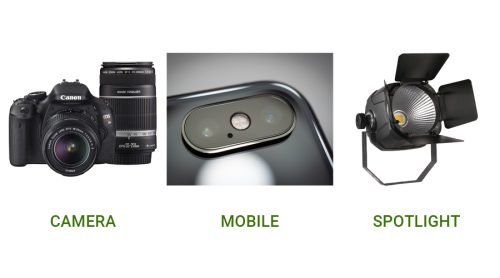
SMD LED flísar
SMD LED hafa tiltölulega breitt úrval af forritum. Lítil stærð þeirra gerir þá þægilega fyrir uppsetningu í ýmsum tækjum, þar á meðal LED perur, skrautljósaræmur, LED vaxtarljós, RGB litaljós og mismunandi LED innréttingar.
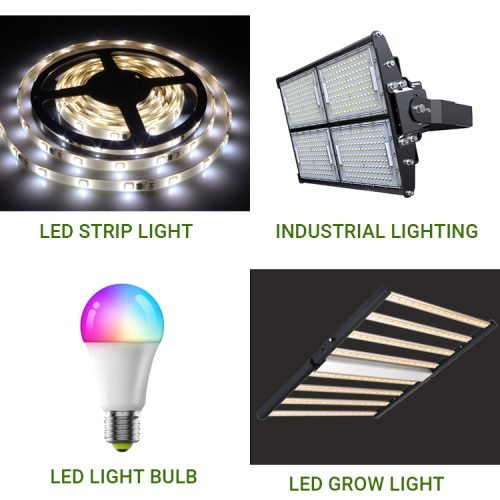
Raunveruleg frammistaða Chip LED
Til að meta raunverulegan árangur þessara LED flísategunda höfum við útvegað forskriftir fyrir DIP, SMD og COB LED, sem allar gefa frá sér kalt hvítt ljós.
- DIP LED: Rekstrarspenna 3,6-4 volt, dregur 30 mA og hefur 22 gráðu losunarhorn.
- SMD LED: Rekstrarspenna 3-3,2 volt, straumur 65 mA og losunarhorn 120 gráður.
- Afkastamikil SMD LED: Rekstrarspenna 3-3,2 volt, orkunotkun 1 watt og 130 gráður losunarhorn.
- COB LED: Rekstrarspenna 9,6-11 volt, afl 10 vött og útblásturshorn 120 gráður.
Næst skulum við mæla raunverulegt birtustig þeirra. Með hverri LED tegund með tilgreinda spennu og staðsett í 50 sentímetra fjarlægð frá LED, fengum við eftirfarandi birtumælingar:
- DIP LED: lýsingarstyrkur 96 Lux
- SMD LED: lýsingarstyrkur 29 Lux
- High Power SMD LED: 121 Lux lýsingarstyrkur
- COB LED: Hámarkslýsingu 1.423 Lux

Ef þú vilt breyta birtumælingum í ljósstreymi geturðu notað eftirfarandi formúlu:
Ljósstreymi (í lúmenum) = Ljósstyrkur (í lúxum) × Flatarmál (í fermetrum)
Til að breyta birtustigi í ljósstyrk þarftu ljósstyrk LED og útblásturshorn. Þar sem mælingarnar sem gefnar eru upp eru í lux (ljósstyrk) getum við breytt þeim í ljósstyrk með því að margfalda birtustigið með mældri fjarlægð.
Með því að taka DIP LED sem dæmi, með því að margfalda lýsingargildið 96 lux með veldi mældrar fjarlægðar (0,5 metrar), fáum við 24 cd. Miðað við að geislahornið (þeta) sé 22 gráður er áætlað ljósstreymi um það bil 2,77 lúmen.
Fyrir SMD LED, með 29 lúx ljósstyrk og 120 gráðu geislahorn, er áætlað ljósstreymi um það bil 22,78 lúmen.
Þegar um er að ræða afkastamikla SMD LED, með 121 lúx lýsingu og geislahorni 130 gráður, er áætlað ljósstreymi um það bil 109,75 lúmen.
Fyrir COB LED, með 1.423 lúx ljósstyrk og 120 gráðu geislahorn, er áætlað ljósstreymi um það bil 1.117,62 lúmen.
Hver er bjartasta LED flísinn?
Þegar við höfum náð nægilegri birtu getum við borið saman ljósgeislun mismunandi LED gerða.
Með öðrum orðum, við viljum ákvarða hvaða LED getur veitt meiri framleiðslu við sömu orkunotkun. Með því að nota eftirfarandi formúlu getum við reiknað gögnin:
- DIP LED: Um það bil 42,78 lm/W
- SMD LED: Um það bil 102,67 lm/W
- Aflmikil SMD LED: Um það bil 109,42 lm/W
- COB LED: Um það bil 111,62 lm/W
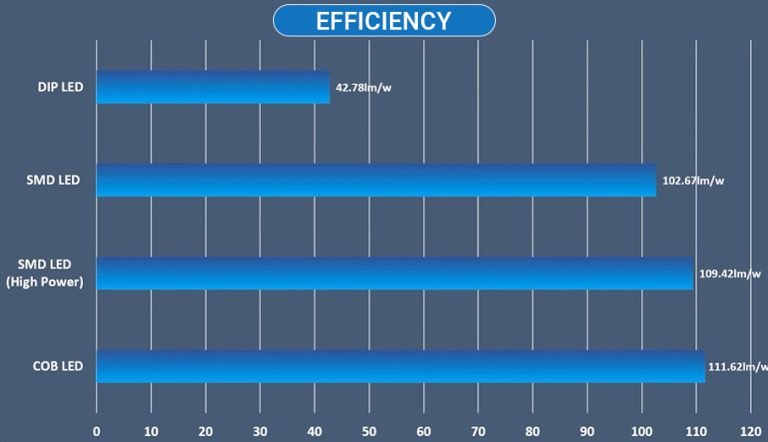
Af þessari greiningu er augljóst að COB LED hafa meiri skilvirkni samanborið við aflmikla SMD, venjulega SMD og DIP LED flís. Hins vegar, í raunhæfum aðstæðum, eru aðrir þættir sem þarf að hafa í huga.
LED geta ekki breytt allri raforku í ljósorku. Raforku sem eftir er er breytt í hitaorku, sem getur haft áhrif á frammistöðu LED þegar hitastigið hækkar.
Nú þurfum við að mæla breytileika í birtustigi og hitastigi ljósdíóðunnar við venjulega notkun.
Fyrir þessa prófun mun ég festa hitaeiningu við ljósdíóðann án þess að hafa áhrif á lýsinguna og fylgjast með hitabreytingum ljósdíóðunnar á stuttum tíma í 10 mínútur.
DIP LED klemmur

Á fyrstu 3 mínútunum hækkar hitastig DIP LED úr 20,1 gráðum á Celsíus í 28,2 gráður á Celsíus.
Hins vegar, á næstu 7 mínútum, helst hitastig LED tiltölulega stöðugt, á bilinu 27 til 28 gráður á Celsíus. Í gegnum þetta ferli helst birtustig DIP LED stöðugt 96 lux.
SMD LED klemma
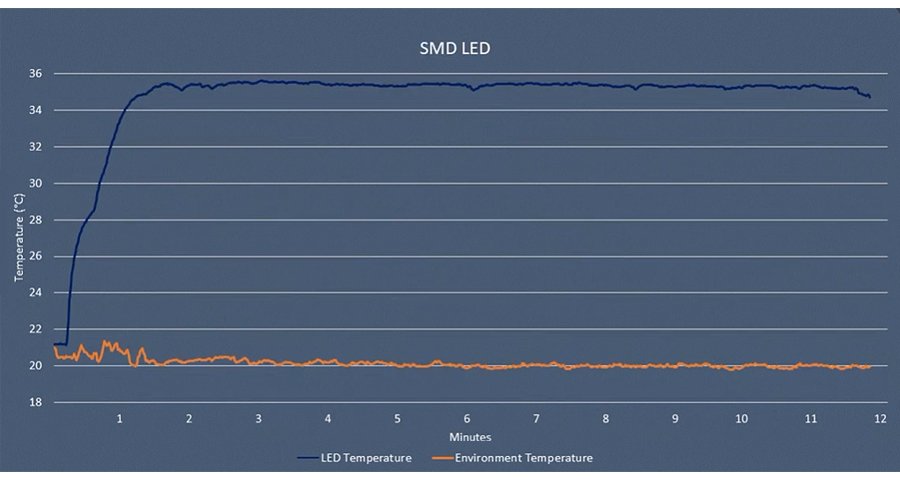
Hitastig SMD LED hækkar úr 21,1 gráðum á Celsíus í 35,4 gráður á Celsíus, sem tekur samtals tvær mínútur.
Í kjölfarið helst hitastigið stöðugt á milli 35,2 og 35,6 gráður á Celsíus. Birtustigið er hins vegar ekki fyrir áhrifum af hitastigi og helst stöðugt í 29 lux.
High Power SMD LED Clip

Eftir að kveikt er á henni eykst hitastig SMD LED ljósdíóðunnar stöðugt þar til það byrjar að lækka hægt eftir 4 mínútur. Hámarkshiti sem SMD LED LED getur náð er 88,94 gráður á Celsíus.
Meðan á hitastigi stendur lækkar birtustigið úr upphaflegu 121 lux í 93 lux eftir 10 mínútur.
COB LED klemmur
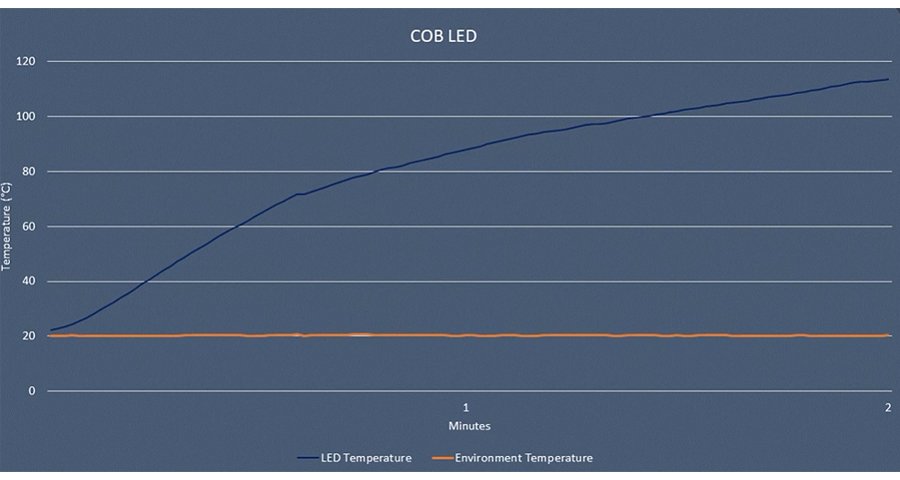
Við prófun á COB LED er nauðsynlegt að nota hitaskáp sem forsenda. Til að koma í veg fyrir skemmdir hefur verið ákveðið að stytta prófunartímann í 2 mínútur án hitaupptöku.
Þegar kveikt er á honum hækkar hitastig COB um 1 til 2 gráður á sekúndu. Eftir aðeins eina mínútu nær mældur hiti 87,9 gráður á Celsíus. Á annarri mínútu er hitinn þegar kominn í 113,5 gráður á Celsíus.
Hins vegar lækkar birtustigið einnig úr 1.423 lux í 917 lux við þessar aðstæður, sem hefur veruleg áhrif á skilvirkni þeirra.
Þessi athugun sýnir upphitunarvandamálið sem aflmikil LED ljósdíóða stendur frammi fyrir þegar þær eru notaðar án viðeigandi hitaleiðniráðstafana, svo sem hitaskáp.
Hlýjar ábendingar
Ef réttri hitaleiðni næst ekki getur frammistaða LED haft áhrif á hitastigið sem það gefur frá sér.
Hjá Auxgrow eru LED vaxtarljósin okkar hönnuð með framúrskarandi hitaleiðni. Markmið okkar er að tryggja að LED plöntuljósin virki vel og veitir notendum tryggingu fyrir öryggi.
Ljósdíóðir nota venjulega ál hringrásarplötur, einnig þekktar sem ál PCB, sem hafa yfirburða hitaleiðni. Þessi eiginleiki hjálpar mjög við hitaleiðni LED.
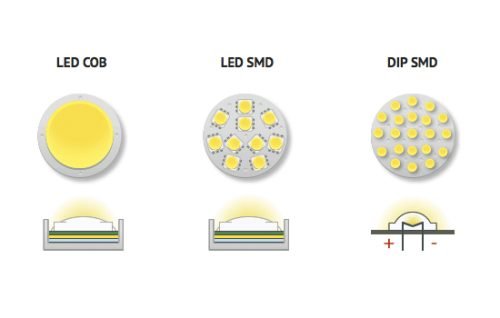
Hver er besti LED ljósaflísinn?
Burtséð frá gerð LED klemmu, hver hefur sína kosti og galla. Það er erfitt að halda því fram að ein flís sé endanlega æðri öðrum.
Besti LED flísinn er sá sem hentar þínum þörfum og kröfum. Kannaðu valkosti þína, íhugaðu kröfur þínar og taktu upplýsta ákvörðun.
Að velja réttan LED flís er lykilatriði fyrir sérstakar lýsingarþarfir þínar fyrir innanhússplöntur. Auxgrow veitir bestu LED lýsingarlausnirnar fyrir plönturnar þínar.
Auxgrow sérhæfir sig í að bjóða upp á breitt úrval af hágæða LED plöntuljósum og ljósflísum til að mæta einstökum kröfum garðyrkju innanhúss.
Ekki missa af tækifærinu til að veita grænu vinum þínum bestu lýsingu. Hafðu samband við Auxgrow í dag til að læra hvernig LED vaxtarljósin okkar geta umbreytt garðyrkju þinni innandyra.
Jayes
Sem stafrænn markaðsstjóri hjá AUXGROW sameinar Jayes ástríðu fyrir vatnsræktunarkerfum og sérfræðiþekkingu í LED vaxtarljósum. Með praktískri reynslu og djúpum skilningi leiðir Jayes þig í gegnum heim sjálfbærrar ræktunar.

